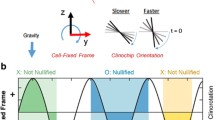Abstract
The effect of altered gravity on single cells has been reported in a number of studies. From the investigation of the immune system response to spaceflight conditions, interest has focused on the influence of gravity on single lymphocytes. Microgravity has been shown to decrease lymphocyte activation and to influence motility. On the other hand, the effect of hypergravity on lymphocyte motility has not been explored. We studied the migration of human peripheral blood T lymphocytes cultured in vitro in a hypergravity environment (10g). After hypergravity culture for 1–11 days, T cells were seeded on a fibronectin-coated glass surface, observed by time-lapse bright-field microscopy, and tracked by a computer program. We found that T cells, activated and then cultured in hypergravity, become motile earlier than cells cultured at normal gravity. These results suggest that hypergravity stimulates T cell migration.


Similar content being viewed by others
References
Bergman AJ, Zygourakis K (1999) Migration of lymphocytes on fibronectin-coated surfaces: temporal evolution of migratory parameters. Biomaterials 20:2235–2244
Cogoli A (1993) The effect of hypogravity and hypergravity on cells of the immune systems. J Leukoc Biol 54:259–268
Cogoli A (1997) Signal transduction in T lymphocytes in microgravity. Gravit Space Biol Bull 10:5–16
Cogoli A, Cogoli-Greuter M (1997) Activation and proliferation of lymphocytes and other mammalian cells in microgravity. Adv Space Biol Med 6:33–79
Cogoli A, Tschopp A, Fuchs-Bislin P (1984) Cell sensitivity to gravity. Science 225:228–230
Cogoli-Greuter M (2004) Effect of gravity changes on the cytoskeleton in human lymphocytes. Gravit Space Biol Bull 17:27–38
Cogoli-Greuter M, Pippia P, Sciola L, Cogoli A (1994) Lymphocytes on sounding rocket flights. J Gravit Physiol 1:P90–P91
Cogoli-Greuter M, Meloni MA, Sciola L, Spano A, Pippia P, Monaco G, Cogoli A (1996) Movements and interactions of leukocytes in microgravity. J Biotechnol 47:279–287
Cooper D, Pellis NR (1998) Suppressed PHA activation of T lymphocytes in simulated microgravity is restored by direct activation of protein kinase C. J Leukoc Biol 63:550–562
Cooper D, Pride MW, Brown EL, Risin D, Pellis NR (2001) Suppression of antigen-specific lymphocyte activation in modeled microgravity. In Vitro Cell Dev Biol Anim 37:63–65
Cosmi L, Liotta F, Lazzeri E, Francalanci M, Angeli R, Mazzinghi B, Santarlasci V, Manetti R, Vanini V, Romagnani P, Maggi E, Romagnani S, Annunziato F (2003) Human CD8+CD25+ thymocytes share phenotypic and functional features with CD4+CD25+ regulatory thymocytes. Blood 102:4107–4114
Doi M, Edwards SF (1988) The theory of polymer dynamics, reprint edn. Oxford University Press, Oxford
Glade N, Demongeot J, Tabony J (2002) Comparison of reaction-diffusion simulations with experiment in self-organised microtubule solutions. C R Biol 325:283–294
Hashemi BB, Penkala JE, Vens C, Huls H, Cubbage M, Sams CF (1999) T cell activation responses are differentially regulated during clinorotation and in spaceflight. FASEB J 13:2071–2082
Ingber D (1999) How cells (might) sense microgravity. FASEB J 13(Suppl):S3–S15
Lauffenburger D, Rothman C, Zigmond S (1983) Measurement of leukocyte motility and chemotaxis parameters with a linear under-agarose migration assay. J Immunol 131:940–947
Lewis ML (2004). The cytoskeleton in spaceflown cells: an overview. Gravit Space Biol Bull 17:1–12
Lewis ML, Reynolds JL, Cubano LA, Hatton JP, Lawless BD, Piepmeier EH (1998) Spaceflight alters microtubules and increases apoptosis in human lymphocytes (Jurkat). FASEB J 12:1007–1018
Lorenzi G, Fuchs-Bislin P, Cogoli A (1986) Effects of hypergravity on “whole-blood” cultures of human lymphocytes. Aviat Space Environ Med 57:1131–1135
Lorenzi G, Bechler B, Cogoli M, Cogoli A (1988) Gravitational effects on mammalian cells. Physiologist 31:S144–S147
Miller MJ, Wei SH, Parker I, Cahalan MD (2002) Two-photon imaging of lymphocyte motility and antigen response in intact lymph node. Science 296:1869–1873
Pellis NR, Goodwin TJ, Risin D, McIntyre BW, Pizzini RP, Cooper D, Baker TL, Spaulding GF (1997) Changes in gravity inhibit lymphocyte locomotion through type I collagen. In Vitro Cell Dev Biol Anim 33:398–405
Pippia P, Sciola L, Cogoli-Greuter M, Meloni MA, Spano A, Cogoli A (1996) Activation signals of T lymphocytes in microgravity. J Biotechnol 47:215–222
Risin D, Pellis NR (2001) Modeled microgravity inhibits apoptosis in peripheral blood lymphocytes. In Vitro Cell Dev Biol Anim 37:66–72
Schwarzenberg M, Cossu G, Cogoli-Greuter M, Meloni MA, Pippia P, Cogoli A (2000). Gravitational effects on the response to different stimulatory signals in T cells. J Gravit Physiol 7:P9–P11
Sciola L, Cogoli-Greuter M, Cogoli A, Spano A, Pippia P (1999). Influence of microgravity on mitogen binding and cytoskeleton in Jurkat cells. Adv Space Res 24:801–805
Sundaresan A, Risin D, Pellis NR (2002) Loss of signal transduction and inhibition of lymphocyte locomotion in a ground-based model of microgravity. In Vitro Cell Dev Biol Anim 38:118–122
Tabony J (2004) Gravity dependence of microtubule self-organisation. Gravit Space Biol Bull 17:13–26
Todd P (1989) Gravity-dependent phenomena at the scale of the single cell. Gravit Space Biol Bull 2:95–113
Tolić-Nørrelykke IM, Butler JP, Chen J, Wang N (2002) Spatial and temporal traction response in human airway smooth muscle cells. Am J Physiol Cell Physiol 283:C1254–C1266
Tschopp A, Cogoli A (1983) Hypergravity promotes cell proliferation. Experientia 39:1323–1329
Walther I, Pippia P, Meloni MA, Turrini F, Mannu F, Cogoli A (1998) Simulated microgravity inhibits the genetic expression of interleukin-2 and its receptor in mitogen-activated T lymphocytes. FEBS Lett 436:115–118
Walther I, Cogoli A, Pippia P, Meloni MA, Cossu G, Cogoli M, Schwarzenberg M, Turrini F, Mannu F (1999) Human immune cells as space travelers. Eur J Med Res 4:361–363
Acknowledgements
We thank Proto Pippia (University of Sassari, Italy), and Alamelu Sundaresan (NASA/Johnson Space center, USA) for useful discussion and suggestions. I. M. Tolić-Nørrelykke acknowledges support from the Italian Space Agency (ASI; research contract I/R/333/02). This work was also supported by the PRIN 2003 project of the Italian Minister of University and Research (MIUR), the LENS contract HPRI-CT-1999-00111 CE, and the Ente Cassa di Risparmio di Firenze.
Author information
Authors and Affiliations
Corresponding author
Rights and permissions
About this article
Cite this article
Galimberti, M., Tolić-Nørrelykke, I.M., Favillini, R. et al. Hypergravity speeds up the development of T-lymphocyte motility. Eur Biophys J 35, 393–400 (2006). https://doi.org/10.1007/s00249-006-0046-x
Received:
Revised:
Accepted:
Published:
Issue Date:
DOI: https://doi.org/10.1007/s00249-006-0046-x




